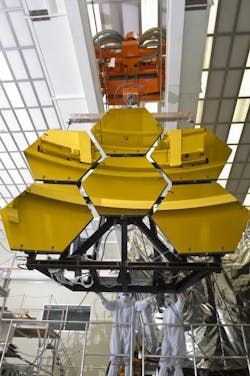Six James Webb Space Telescope mirror segments complete final cryogenic test
Huntsville, AL--The first six of 18 hexagonal gold-coated mirrors that will form the 6.5 m primary mirror of NASA's James Webb Space Telescope (JWST) completed their final cryogenic testing this past week at the Marshall Space Flight Center. A second set of six segments will arrive at Marshall in late July to begin testing, and the final set of six will arrive in the fall. The mirror segments began their cryopolishing a little over a year ago.
The ten-week test series included two test cycles in which the mirrors were chilled down to -228°C, then back to ambient to ensure the mirrors respond as expected to the extreme temperatures of space.
The beryllium mirror segments are coated with gold for high reflectivity in the infrared. Each segment weights about 40 kg. The X-ray and Cryogenic Facility at NASA's Marshall Space Flight Center provides the space-like environment for testing.
The JWST is scheduled to launch around 2018, and should be able to image astronomical objects farther away (and earlier in the history of the universe) than ever achieved. The telescope is a combined project of NASA, the European Space Agency and the Canadian Space Agency. Northrop Grumman is the prime contractor under NASA's Goddard Space Flight Center (Greenbelt, MD). Ball Aerospace & Technologies (Boulder, CO) is responsible for mirror development. L-3- Tinsley Laboratories (Richmond, CA) is responsible for mirror grinding and polishing.
Subscribe now to Laser Focus World magazine; it’s free!
About the Author
John Wallace
Senior Technical Editor (1998-2022)
John Wallace was with Laser Focus World for nearly 25 years, retiring in late June 2022. He obtained a bachelor's degree in mechanical engineering and physics at Rutgers University and a master's in optical engineering at the University of Rochester. Before becoming an editor, John worked as an engineer at RCA, Exxon, Eastman Kodak, and GCA Corporation.

